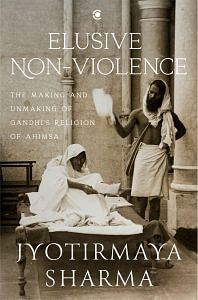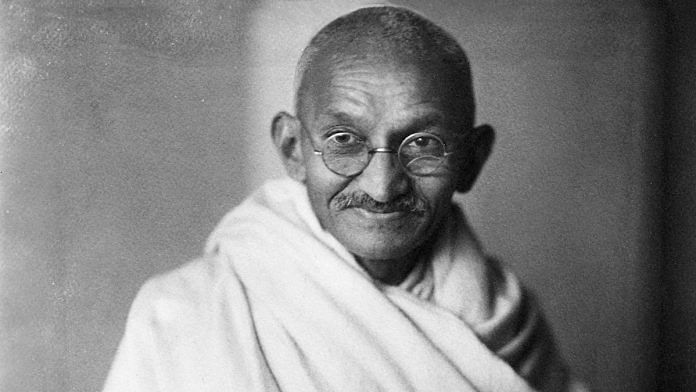In July 1918, Gandhi confesses to facing difficulties. Thinking hard has affected him physically and emotionally. He feels listless and has little motivation to read, write, speak or meet people. Given this state, he has defaulted in answering letters received from C.F. Andrews. But despite his listlessness, he cherishes the communication from Andrews, as also their friendship, a great deal and decides to dictate a letter on 6 July 1918.
Andrews’s letter was in response to an earlier note from Gandhi in June 1918. In it, Gandhi made an unusual claim. Ahimsa cannot be taught to a man who is incapable of killing, he wrote. Even though a dumb person cannot be made to appreciate the beauty and excellence of silence, efforts ought to be made to restore his faculty of speech. Similarly, violent men have to exhaust their capacity for violence in order to value the worth of non-violence.
Andrews rejected this analogy, observing that Gandhi’s logic is dangerously close to suggesting that those who had forgotten bloodlust ought to be reinitiated into violence for them to learn the virtues of ahimsa and repudiate himsa.
Gandhi’s letter of 6 July is a unique and unusually forthright response to Andrews on the theme of violence and non-violence. He begins by questioning Andrews’s belief that Indians as a race had rejected violence, especially the desire to kill others, in the past and had consciously chosen ‘to stand on the side of humanity’. Departing from his ceaseless reiteration of non-violence as a fundamental principle of Hinduism, he questions the historical validity of Andrews’s conclusion. Although regularly uncharitable towards history and historical argumentation, he now sees an absence of non-violence in the Mahabharata, the Ramayana, and even in Tulsidas’s version of the Ramayana, which he considered superior to Valmiki’s original in its spiritual content. Here, he relies on his method of reading a scriptural text, which, when applied, always privileges the central spiritual message over changes in context. Also, everything in a text that contradicts certain timeless and identifiable fundamental principles is to be seen as an interpolation and, hence, ruthlessly rejected. But in responding to Andrews’s conviction about non-violence in India, Gandhi resurrects the very thing he might otherwise have rejected as an interpolation. ‘Is this historically true?’ he asks, posing the question in opposition to his judgement that non-violence is a fundamental principle of Hinduism but also, that all religions essentially preach peace. History and interpolation converge, even seamlessly conflate, in this instance.
Maintaining that he was not looking at these texts in any spiritual sense whatsoever, Gandhi describes their pages as being full of accounts of incarnations that were bloodthirsty, vengeful, and merciless towards their enemies. These incarnations did not shy away from deceit and trickery to subdue their adversaries. Battles are described in these texts with as much enthusiasm as in contemporary times; warriors possess and use unimaginably deadly weapons. Even Tulsidas’s fine poem in praise of Lord Rama gives unmistakable primacy to Rama’s ability to kill his enemies. In more recent times, the Hindus were as eager to fight as the Muslims, even if they were disorganised, physically weak, and torn apart by mutual discord. Refuting Andrews’s attempt to attribute tolerance and non-violence to Buddhism, Gandhi declares the Buddha’s doctrine of universal forbearance to be a demonstrable failure. If legend is to be believed, Shankaracharya successfully banished Buddhism from India by using ineffable cruelty. Equally, Gandhi dismisses the idea that Manu stipulates a rejection of violence in his book of law, Mānava Dharmaśāstra. Even the Jains, Gandhi contends, had failed to propagate non-violence. While they had a ‘superstitious horror of blood(shed)’, they rejoiced like everyone else when an enemy was vanquished. Only the period of English rule had enforced a compulsory abandoning of violence, though not necessarily the desire to kill.
Also read: Mahatma Gandhi is arriving shortly
Stark and unequivocal are the words, then, in which Gandhi answers the question he himself had posed about non-violence’s provenance in India.
All then that can be said of India is that individuals have made serious attempts, with greater success than elsewhere, to popularize the doctrine [of non-violence]. But there is no warrant for the belief that it has taken deep roots among the people.
He bristles at Andrews’s suggestion that non-violence might have become an unconscious instinct among Indians, a quality that could be rekindled at will, as Gandhi himself had shown. He considers the proposition that people took to passive resistance as a weapon of the weak to be laughable and libellous. For a few of his co-workers and himself, passive resistance in the form of satyagraha came out of strength. But for a vast majority of people, it was mere passive resistance born out of weakness in the face of inability to resort to violence. Giving the examples of the Kheda and Champaran satyagraha, Gandhi reports that a substantial number of people participating in these felt that violence was more manly than satyagraha. These individuals just did not have the spirit in them to refuse to comply with an unjust order or an unfair law. Neither did they possess the fearless courage to face the hangman’s noose or stand firm in the face of bullets showered on them. This spirit of daring and principled determination was unlikely to surface until they received appropriate training to defend themselves.
What did such a training imply? For Gandhi, a complete and adequate development of physical strength is an absolute condition for appreciating and absorbing the merits of non-violence. Ahimsa can only be inculcated in a person who is physically forceful and has the ability to face an adversary. Gandhi concedes Andrews’s claim that India’s moral force can withstand and repulse the mightiest armies in the world, but maintains that India needs to be physically strong in order to begin understanding even the first principles of this moral force. To illustrate his point, he mentions a prayer millions recite each day without understanding its meaning. If only they could appreciate its significance, they would be in a position to repel the most formidable armies. But this capacity does not exist and is unlikely to, as long as freedom and fearlessness do not prevail in the land. It would take independence and absence of fear to enable a vast number of people to protect themselves from all manner of violence. However, Gandhi, till this juncture, does not reveal what constitutes the moral force that can take on and push back the most fearsome armies in the world.
Not surprisingly, Gandhi reveals that the great moral idea and force for him is moksha. But moksha cannot be handled by a child—the child must be allowed to grow into a man before being introduced to it. It must be allowed attachment to the body and to explore the overall implications of such a bond. Once the infant understands the body well and learns of the infinite possibilities of a robust physique, the transitory nature of the body and the world will be divulged to it. At this moment, it will learn that the body is not to be wasted in gratifying itself but is to be used as a vehicle of liberation. Once India, masquerading as a child in Gandhi’s view, understands moksha, it will also assimilate the doctrine of ahimsa, which is nothing but the creed of perfect love. Going beyond instilling moksha and ahimsa in the mind, Gandhi now wishes to ponder the practical application of these ideas.
Also read: Gandhi was like Adam Smith in his thinking. But Gandhian studies won’t tell you this
Translating the sense of having a vigorous body to the Indian context, Gandhi wonders if every individual should possess the power to use violence and to what extent they ought to go in gaining the ability to strike violently. Alternatively, they could draw enough personal courage from the prevailing spirit of freedom that could make the need for violence redundant. Holding the latter view to be correct, Gandhi offers an example. After all, he had supported the British during the First World War and even encouraged Indians to join the army. But he had done so by asking them to join the war effort, not to shed blood but to overcome their fear of death, not to kill Germans but to die for India and the Empire. He imagines having raised an army of fearless men who would lay down their weapons because their hearts overflowed with love for the enemy. They would even ask the Germans to shoot them. Surely, he concludes, this act of love and the readiness to die would melt even the German heart.
Moksha and ahimsa may be the culmination of the ultimate human quest, but to reach this desirable state, one has to go through the process of knowing the body and attaining physical maturity. In this sense, postulates Gandhi, war and the body are not dissimilar. War, like the body, is a necessary evil, resorted to in exceptional circumstances if the motive to go to war is just. In such cases, war may benefit humankind, and a follower of ahimsa must not be an indifferent bystander when such a righteous war is waged. He must either actively co-operate or strenuously resist.
Gandhi’s candid reply to Andrews discloses two distinct yet interconnected lines of enquiry. The recognition and reality of violence is the first. The second is the insertion and legitimation of non-violence as a fundamental principle of Hinduism. Nestled between these two parallel lines of investigation are questions of fearlessness, courage, manliness, cowardice, weakness, harm, force, the body, the senses, suffering, forgiveness, patience, punishment, and death. But it is also critical to examine the historical and conceptual status of concepts such as himsa and ahimsa independent of their use by Gandhi. A logical step in this direction is to start with violence and its role in defining Gandhi’s religion of ahimsa.
 This excerpt from ‘Elusive Non-Violence: The Making and Unmaking of Gandhi’s Religion of Ahimsa’ by Jyotirmaya Sharma has been published with permission from Context, October 2021.
This excerpt from ‘Elusive Non-Violence: The Making and Unmaking of Gandhi’s Religion of Ahimsa’ by Jyotirmaya Sharma has been published with permission from Context, October 2021.



